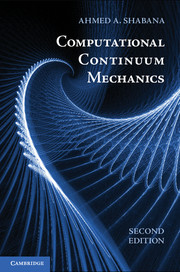Book contents
- Frontmatter
- Contents
- Preface
- 1 Introduction
- 2 Kinematics
- 3 Forces and Stresses
- 4 Constitutive Equations
- 5 Plasticity Formulations
- 6 Finite Element Formulation: Large-Deformation, Large-Rotation Problem
- 7 Finite Element Formulation: Small-Deformation, Large-Rotation Problem
- 8 Computational Geometry and Finite Element Analysis
- References
- Index
4 - Constitutive Equations
Published online by Cambridge University Press: 05 June 2012
- Frontmatter
- Contents
- Preface
- 1 Introduction
- 2 Kinematics
- 3 Forces and Stresses
- 4 Constitutive Equations
- 5 Plasticity Formulations
- 6 Finite Element Formulation: Large-Deformation, Large-Rotation Problem
- 7 Finite Element Formulation: Small-Deformation, Large-Rotation Problem
- 8 Computational Geometry and Finite Element Analysis
- References
- Index
Summary
The kinematic and force equations developed in the preceding two chapters are general and applicable to all types of materials. The mechanics of solids and fluids is governed by the same equations, which do not distinguish between different materials. The definitions of the strain and stress tensors, however, are not sufficient for describing the behavior of continuous bodies. The force–displacement relationship or equivalently the stress–strain relationship is required in order to be able to distinguish between different materials and solve the equilibrium equations. The continuum displacements depend on the applied forces, and the force–displacement relationship depends on the material of the continuum. To complete the specification of the mechanical properties of a material, one needs additional set of equations called the constitutive equations, which serve to distinguish one material from another. The form of the constitutive equations of a material should not be altered in the case of a pure rigid-body motion. These equations, therefore, must be objective, and should not lead to change in the work and energy of the stresses under an arbitrary rigid-body motion. Using the constitutive equations, the partial differential equations of equilibrium obtained in the preceding chapter can be expressed in terms of the strains. Using the strain–displacement relationships, these equilibrium equations can be expressed in terms of displacements or position coordinates and their time and spatial derivatives. If the continuum density is considered as an unknown variable, as it is the case in some fluid applications, the continuity equations can be added to the resulting system of partial differential equations in order to have a number of equations equal to the number of unknowns.
If the constitutive equations of a material depend only on the current state of deformation, the behavior is said to be elastic. If the stresses can be derived from a stored energy function, the material is termed hyperelastic or called Green elastic material. A more general class of materials, for which the stresses cannot be derived from a stored energy function, is called Cauchy elastic material. For hyperelastic materials, the work done by the stresses during a deformation process is path independent. That is, the work done depends only on the initial and final states. For such systems, the continuum returns to its original configuration after the load is released. For viscoelastic materials, on the other hand, the work done during a deformation process is path dependent due to the dissipation of energy during the deformation process. The constitutive equations of viscoelastic materials are formulated in terms of rate of deformation measures in order to account for the energy dissipation.
- Type
- Chapter
- Information
- Computational Continuum Mechanics , pp. 123 - 163Publisher: Cambridge University PressPrint publication year: 2011

